1998 GMC SIERRA flat tire
[x] Cancel search: flat tirePage 7 of 452
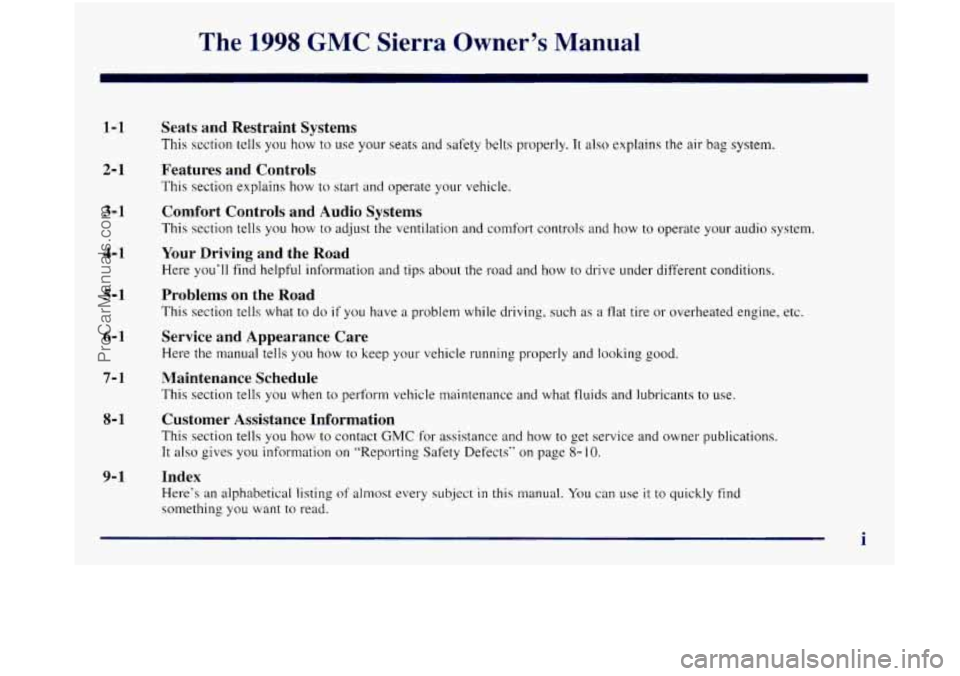
The 1998 GMC Sierra Owner's Manual
1-1
2- 1
3- 1
4- 1
5-1
6-1
7-1
8- 1
9-1
Seats and Restraint Systems
This section tells you how to use your seats and safety belts properly. Tt also explains the air bag system.
Features and Controls
This section explains how to start and operate your vehicle.
Comfort Controls and Audio Systems
This section tells you how to adjust the ventilation and comfort controls and how to operate your audio system.
Your Driving and the Road
Here you'll find helpful information and tips about the road and how to drive under different conditions.
Problems on the Road
This section tells what to do if you have a problem while driving? such as a flat tire or overheated engine, etc.
Service and Appearance Care
Here the manual tells you how to keep your vehicle running properly and looking good.
Maintenance Schedule
This section tells you when to perform vehicle maintenance and what fluids and lubricants to use.
Customer Assistance Information
This section tells you how to contact GMC for assistance and how to get service and owner publications.
It also gives you information on "Reporting Safety Defects" on page 8- 10.
Index
Here's an alphabetical listing of almost every subject in this manual. You can use it to quickly find
something you want to read.
i
ProCarManuals.com
Page 20 of 452
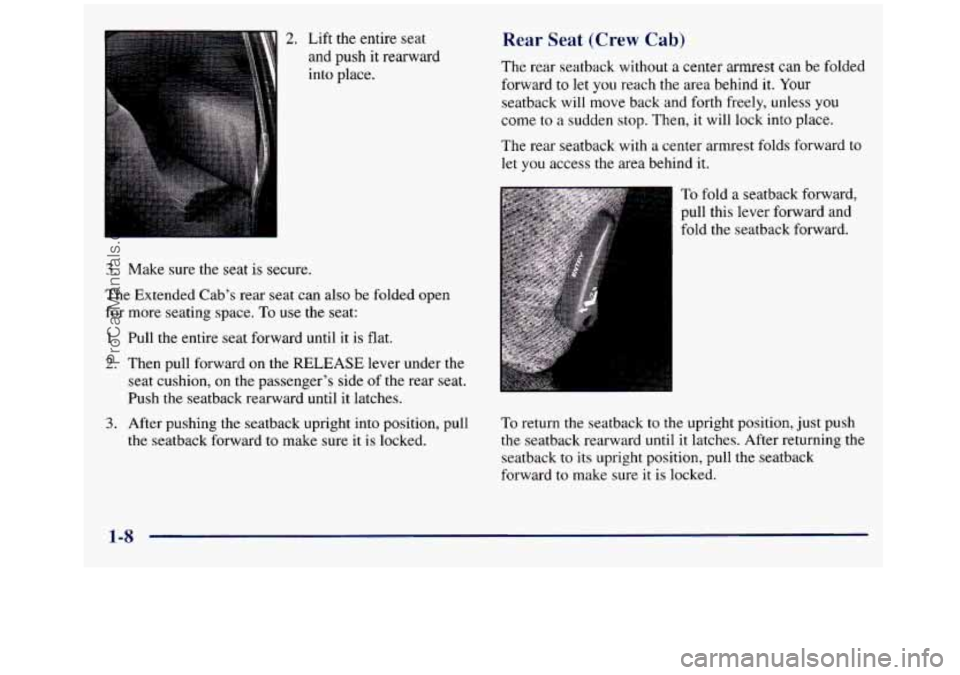
2. Lift the entire seat
and push it rearward
into place.
3. Make sure the seat is secure.
The Extended Cab’s rear seat can also be folded open
for more seating space.
To use the seat:
1. Pull the entire seat forward until it is flat.
2. Then pull forward on the RELEASE lever under the
seat cushion,
on the passenger’s side of the rear seat.
Push the seatback rearward until it latches.
3. After pushing the seatback upright into position, pull
the seatback forward to make sure it is locked.
Rear Seat (Crew Cab)
The rear seatback without a center armrest can be folded
forward to let you reach the area behind it. Your
seatback will move back and forth freely, unless you
come to a sudden stop. Then, it will lock into place.
The rear seatback with
a center armrest folds forward to
let
you access the area behind it.
To fold a seatback forward,
pull this lever forward and
fold the seatback forward.
To return the seatback to the upright position, just push
the seatback rearward until it latches. After returning the
seatback to its upright position, pull the seatback
forward to make sure it is locked.
1-8
ProCarManuals.com
Page 202 of 452
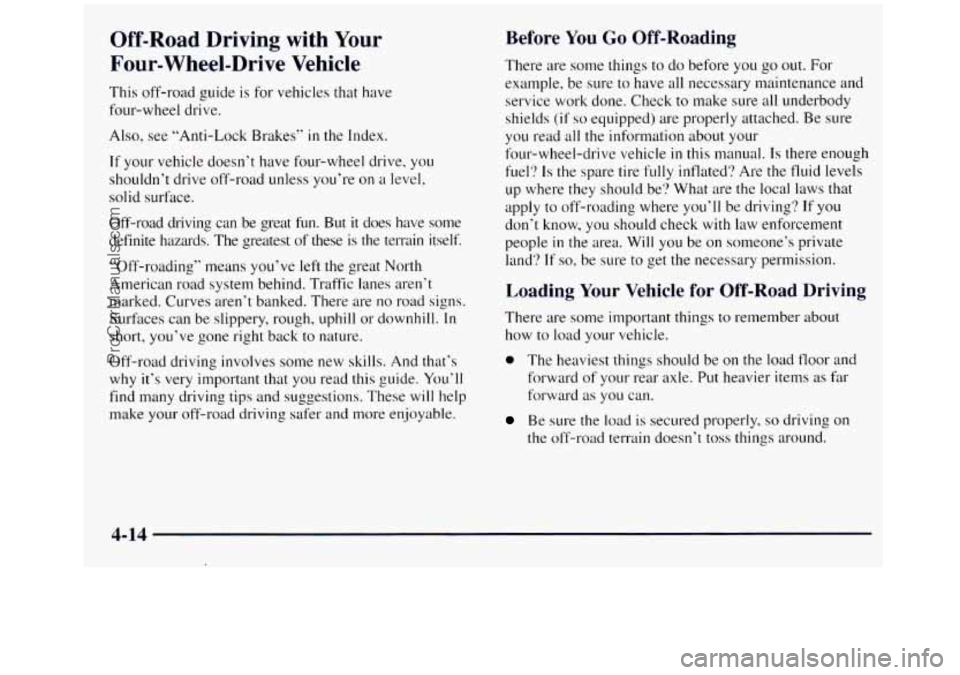
Off-Road Driving with Your
Four-Wheel-Drive
Vehicle
This off-road guide is for vehicles that have
four-wheel drive.
Also, see “Anti-Lock Brakes“
in the Index.
If your vehicle doesn’t have four-wheel drive, you
shouldn’t drive off-road unless you’re on a level,
solid surface.
Off-road driving can be great fun. But
it does have some
definite hazards. The greatest of these is the terrain itself.
“Off-roading” means you’ve left
the great North
American road system behind. Traffic lanes aren’t
marked. Curves aren’t banked. There are
no road signs.
Surfaces can be slippery, rough, uphill or downhill.
In
short, you’ve gone right back to nature.
Off-road driving involves some new skills. And that’s
why it’s very important that you read this guide. You’ll
find many driving tips and suggestions. These
will help
make your off-road driving safer and more enjoyable.
Before You Go Off-Roading
There are some things to do before you go out. For
example, be
sure to have all necessary maintenance and
service work done. Check
to make sure all underbody
shields
(if so equipped) are properly attached. Be sure
you read
all the information about your
four-wheel-drive vehicle
in this manual. Is there enough
firel‘?
Is the spare tire fully inflated? Are the fluid levels
up where
they should be‘? What are the local laws that
apply to off-roading where you’ll be driving?
If you
don’t know, you should check
with law enforcement
people
in the area. Will you be on someone’s private
land?
If so, be sure to get the necessary permission.
Loading Your Vehicle for Off-Road Driving
There are some important things to remember about
how to load your vehicle.
0 The heaviest things should be on the load floor and
forward of your rear axle. Put heavier items
as far
forward
as you can.
Be sure the load is secured properly, so driving on
the off-road terrain doesn’t toss things around.
4-14
ProCarManuals.com
Page 221 of 452
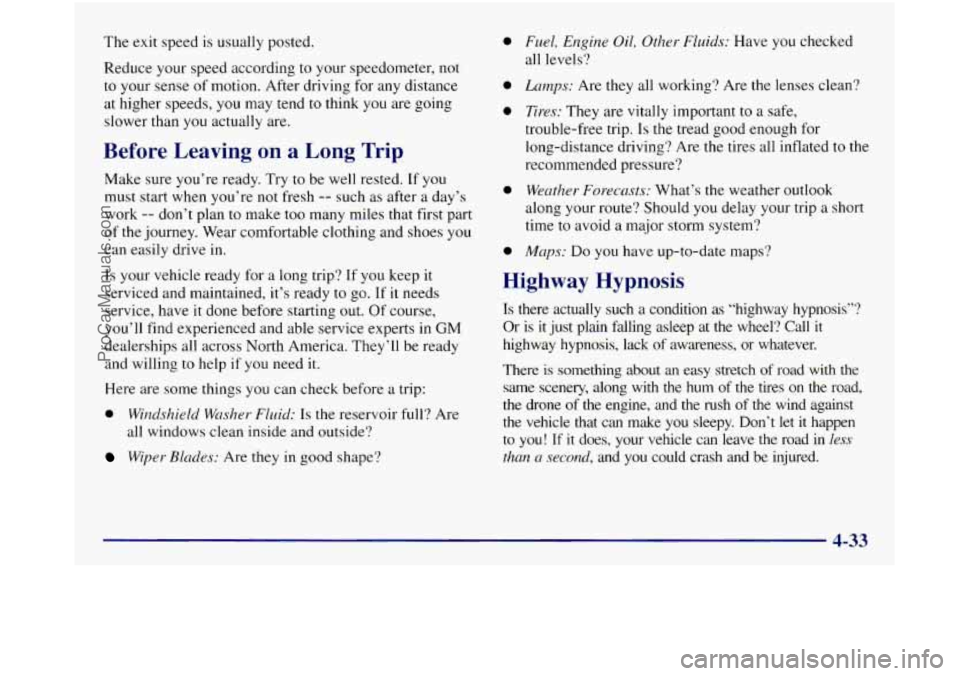
The exit speed is usually posted.
Reduce your speed according
to your speedometer, not
to your sense of motion. After driving for any distance
at higher speeds,
you may tend to think you are going
slower than you actually are.
Before Leaving on a Long Trip
Make sure you’re ready. Try to oe wed rested. If you
must start when you’re not fresh
-- such as after a day’s
work
-- don’t plan to make too many miles that first part
of the journey. Wear comfortable clothing and shoes you
can easily drive in.
Is your vehicle ready for a long trip? If you keep it
serviced and maintained, it’s ready to
go. If it needs
service, have
it done before starting out. Of course,
you’ll find experienced and able service experts in
GM
dealerships all across North America. They’ll be ready
and willing
to help if you need it.
Here are some things you can check before a trip:
0 Windshield Washer Fluid: Is the reservoir full? Are
all windows clean inside and outside?
Wiper Blades: Are they in good shape?
0
0
0
0
0
Fuel, Engine Oil, Other Fluids: Have you checked
all levels?
Lamps: Are they all working? Are the lenses clean?
Tires: They are vitally important to a safe,
trouble-free trip.
Is the tread good enough for
long-distance driving? Are the tires all inflated to the
recommended pressure?
Weather Forecasts: What’s the weather outlook
along your route? Should you delay your trip
a short
time
to avoid a major storm system?
Maps: Do you have up-to-date maps?
Highway Hypnosis
Is there actually such a condition as “highway hypnosis”?
Or is
it just plain falling asleep at the wheel? Call it
highway hypnosis, lack of awareness, or whatever.
There
is something about an easy stretch of road with the
same scenery, along with the hum of the tires on the road,
the drone of
the engine, and the rush of the wind against
the vehicle that can make you sleepy. Don’t let it happen to you! If it does, your vehicle can leave
the road in less
than n second, and you could crash and be injured.
4-33
ProCarManuals.com
Page 231 of 452

Loading Your Vehicle
~EE ~NER'S MANUAL FOR ADDITIONAL INFORMATION. TI
The CertificatiodTire label is found on the rear edge of
the driver's door or in the Incomplete Vehicle Document
in the cab.
The label shows the size of your original tires and the
inflation pressures needed to obtain the gross weight
capacity
of your vehicle. This is called the Gross Vehicle
Weight Rating (GVWR). The GVWR includes the
weight
of the vehicle, all occupants, fuel and cargo.
The CertificatiodTire label also tells you the maximum
weights for the front and rear axles, called Gross Axle
Weight Rating (GAWR).
To find out the actual loads on
your front and rear axles, you need to
go to a weigh
station and weigh your vehicle. Your dealer can help
you with this. Be sure to spread out your load equally on
both sides
of the centerline.
Never exceed the GVWR
for your vehicle, or the
GAWR for either the front or rear axle.
And,
if you do have a heavy load, you should spread
it out.
A CAUTION:
In the case of a sudden stop or collision, things
carried in the bed of your truck could shift
forward and come into the passenger area,
injuring
you and others. If you put things in the
bed of your truck, you should make sure they are
properly secured.
4-43
ProCarManuals.com
Page 243 of 452
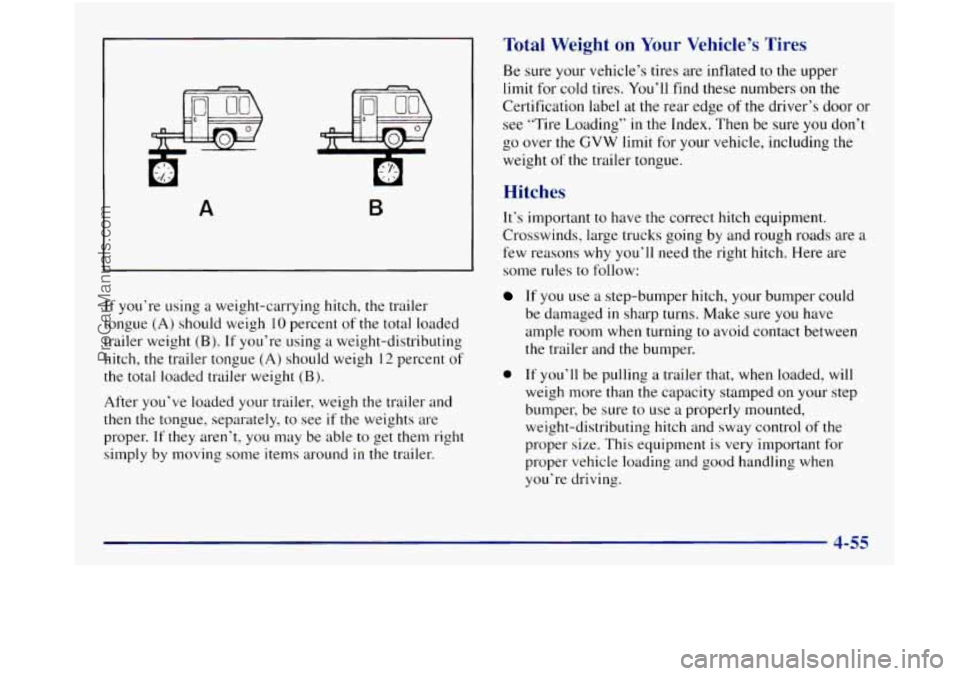
A B
If you’re using a weight-carrying hitch, the trailer
tongue (A) should weigh
10 percent of the total loaded
trailer weight
(B j. If you’re using a weight-distributing
hitch, the trailer tongue
(A) should weigh 12 percent of
the total loaded trailer weight (B).
After you’ve loaded your trailer, weigh the trailer and
then the tongue, separately, to see
if the weights are
proper.
If they aren’t, you may be able to get them right
simply by moving some items around
in the trailer.
Total Weight on Your Vehicle’s Tires
Be sure your vehicle’s tires are inflated to the upper
limit for cold tires.
You’ll find these numbers on the
Certification label at the rear edge
of the driver’s door or
see ”Tire Loading” in the Index. Then be sure you don’t
go over the
GVW limit for your vehicle, including the
weight of the trailer tongue.
Hitches
It’s important to have the correct hitch equipment.
Crosswinds, large trucks going by and rough roads are a
few reasons
why you’ll need the right hitch. Here are
some rules to follow:
If you use a step-bumper hitch, your bumper could
be damaged
in sharp turns. Make sure you have
ample room when turning to avoid contact between
the trailer and the bumper.
0 If you’ll be pulling a trailer that, when loaded, will
weigh more than
the capacity stamped on your step
bumper, be sure
to use a properly mounted,
weight-distributing hitch and sway control
of the
proper size. This equipment
is very important for
proper vehicle loading and good handling when
you’re driving.
ProCarManuals.com
Page 253 of 452
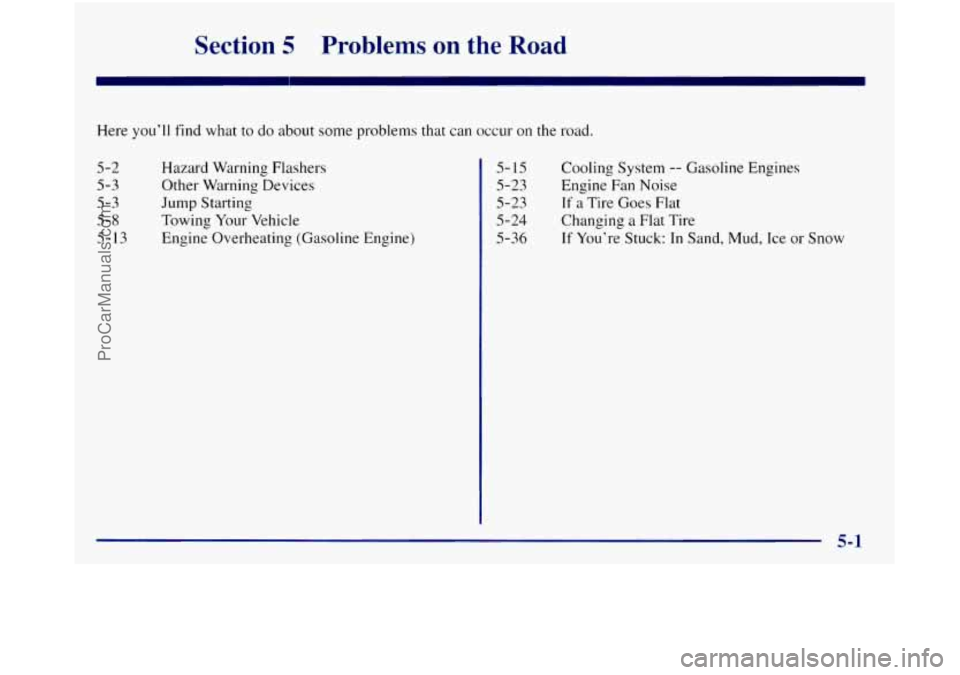
SI ;tion 5 Problems on the Road
Here you’ll find what to do about some problems that can occur on the road.
5-2
5-3
5-3
5-8
5- 13
Hazard Warning Flashers
Other Warning Devices
Jump Starting
Towing Your Vehicle
Engine Overheating (Gasoline Engine) 5- 15
5-23
5-23
5-24
5-36
Cooling System -- Gasoline Engines
Engine Fan Noise
If a Tire Goes Flat
Changing a
Flat Tire
If You’re Stuck: In Sand, Mud, Ice or Snow
5-1
ProCarManuals.com
Page 275 of 452

Engine Fan Noise If a Tire Goes Flat
Your vehicle has a clutched engine cooling fan. When
the clutch is engaged, the fan spins faster to provide
more air to cool the engine.
In most everyday driving
conditions, the fan is spinning slower and the clutch
is
not fully engaged. This improves fuel economy and
reduces fan noise. Under heavy vehicle loading. trailer
towing and/or high outside temperatures, the fan speed
increases as the clutch more
fully engages. So you may
hear an increase
in fan noise. This is normal and should
not be mistaken as the transmission slipping or making
extra shifts.
It is merely the cooling system functioning
properly. The fan
will slow down when additional
cooling
is not required and the clutch disengages.
You may
also hear this fan noise when you start
the engine.
It will go away as the fan clutch
partially disengages. It‘s
unusual for
a tire to “blow out’’ while you’re driving,
especially if you maintain your tires properly.
If air goes
out of a tire, it’s much more likely to leak out slowly.
But if you should ever have a “blowout,” here are a
few tips about what to expect and what to do:
If a front tire hils, the flat tire will create a drag that
pulls the vehicle toward that side. Take your foot off the
accelerator pedal and grip the steering wheel firmly.
Steer to maintain lane position, and then gently brake to
a stop well out of the traffic lane.
A rear blowout, particularly on a curve, acts much like a
skid and may require the same correction you’d use in
a skid. In any rear blowout, remove your foot from
the accelerator pedal. Get
the vehicle under control by
steering the way you want the vehicle to go.
It may be
very bumpy and noisy, but you can still steer. Gently
brake to
a stop -- well off the road if possible.
If a tire goes flat, the next part shows how to use your
jacking equipment to change a flat tire safely.
5-23
ProCarManuals.com